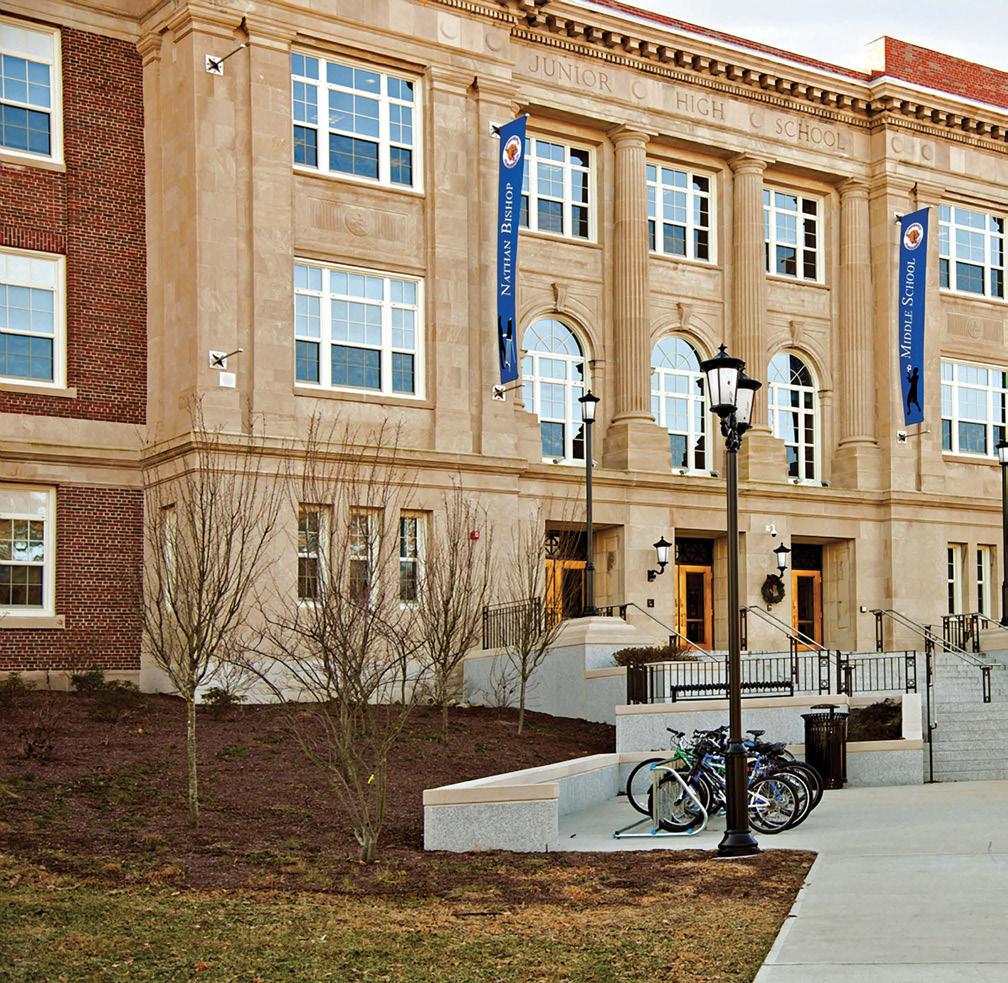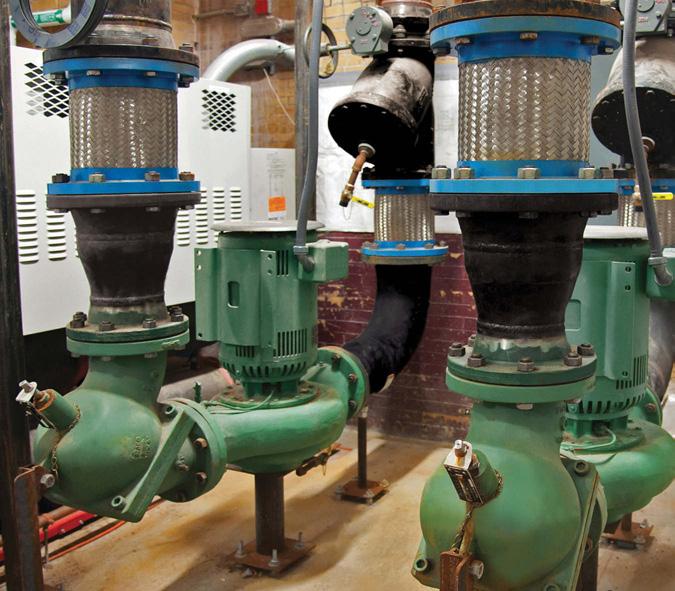
6 minute read
School Gets High Marks For HVAC
by IdeaSoil

Energy savings and reduced operating costs make the grade at a renovated middle school.
Advertisement
AProvidence, RI, middle school dating from 1929 was reborn after sitting idle for nearly fi ve years because of the original structure’s deterioration and the defection of many students to private schools. Then Nathan Bishop Middle School, located on the city’s historic East Side, was entirely gutted and reconstructed in a $36-million renovation project. Committed to rehabbing the building at the behest of parents who protested the school’s closing, the city and the state wanted a model school that would regain city students from private schools because of its commitment to excellence with advanced course offerings and a learning environment that provided the latest technology. Verifying that the school met Collaborative for High Performance Schools (CHPS) standards was an important part of the project. CHPS, which began in California and now extends nationwide, provides school districts free resources for attaining high-performance school design, construction, and operation. The program develops tools to make schools energywater-, and material-effi cient, among other objectives. The 95,000-sq.-ft. school is one of two CHPS-verifi ed schools in Providence.

High-performance HVAC
The renovated school features a very quiet HVAC system that includes advanced hydronic equipment from Taco Inc., Cranston, RI; active chilled beams from NuClimate, East Syracuse, NY; boilers from Fulton Heating Solutions, Pulaski, NY; and custom energy-recovery units by Mafna Air Technologies, Cambridge, Ontario. The system was designed by Griffi th & Vary Inc., a Wareham, MA, consulting-engineering fi rm with extensive experience in mechanical, electrical, and plumbing for elementary and secondary schools.
The mechanical room serving the threestory Nathan Bishop building was originally equipped with steam boilers, which were removed, along with all the rest of the old HVAC equipment, through an old coal chute. With the room completely gutted, mechanical contracting fi rm Delta Mechanical, Warwick, RI, installed two Fulton high-effi ciency, gas-fi red condensing boilers. They also put in a booster pump from Canaris Corp., Riverview, FL, for domestic hot water, since pressure from the city-water supply was not suffi cient for servicing the school’s top fl oor. The boilers came with a control system that provides lead/lag and combustion control. Three modular Multistack (80 tons each) chillers along with eight variable-speed Taco KV pumps (four for the heat side and four to serve the chillers) were also part of the project.



Big results in a small place
The vertical KV pumps’ small footprint was important in a busy equipment space, according to Wayne Mattson, P.E., a principal with Griffi th & Vary and the engineering project manager for the project. He also noted that his fi rm specifi ed only Taco pumps. Additional Taco equipment included multi-purpose valves, an expansion tank, and air separator.
“We chose the Taco pumps specifi cally because of their fl exibility,” Mattson said. “They fi t the application—and the mechanical room—very well. As engineers, we’ve been specifying Taco for years now. Their products are very reliable, and we’ve never had a problem with them.”
In an area off the mechanical room, Griffi th & Vary specifi ed two custom Mafna energyrecovery units. The variable-frequency-driveequipped units supply the school’s classrooms, library, workrooms, and corridors with tempered primary air. Use of active chilled beams helps

Nathan Bishop Middle School stayed true to its 1929 design, along with adding many improvements to increase energy effi ciency and enhance the learning
environment. Photo courtesy of Taco Inc., Cranston, RI.

Formerly the home of antiquated boilers, the small mechanical room now boasts a variety of energy-effi cient equipment for heating and cooling the school.
Photo courtesy of Taco Inc., Cranston, RI.



▲
Students enjoy a modern library that features clerestory windows to admit
natural light. Photo courtesy of Taco Inc., Cranston, RI.



reduce the school’s overall energy consumption. Each classroom has two chilled beams, producing even and consistent temperatures (70 F heating and 75 F cooling) throughout the rooms.
“Nathan Bishop was our fi rst use of chilled beams,” said Mattson. “They were a perfect application for a project of this kind. They’re very simple and easy to understand, there are no moving parts, and they’re very quiet in operation. Air and water temperatures are moderate, and the air supply required is a lower quantity than with a typical variable-airvolume system. All in all, they make for a very comfortable atmosphere at a lower energy cost.”
The sum of the parts
On the school’s roof, six dedicated air-handling units from McQuay, Minneapolis, distribute heat and ventilation to the school’s gymnasium, cafeteria, and 400-seat auditorium. The air handlers capture heat from the building and reuse it. A direct digital-controller building-management system from Johnson Controls, Milwaukee, controls all the air-handling units, boilers, chillers, and hot water pumps and monitors supply and return temperatures for hot and chilled water. To save energy required to heat or cool outside air, carbon-dioxide sensors allow the reduction of outside air during periods of low occupancy. Motion sensors allow closure of outdoor-air dampers when assembly areas are unoccupied.
In addition to an HVAC system that saves energy and reduces operating costs, the city and state wanted a water-conservation component in the design. As a result, a 10,000-gallon underground storage tank was installed to capture rainwater from the roof. Rainwater is fed from the roof to the tank. After fi ltering and sanitizing the storm water through a Megatron ultraviolet water-disinfection system unit from Atlantic Ultraviolet Corp., Hauppauge, NY, it is used for fl ushing toilets and urinals throughout the school, as well as in the school’s cooling towers.
“What’s unique about this school,” says Dave Gaudet, facility manager for Aramark Education, Philadelphia, which holds the contract for the school operations and maintenance, “is its energy-effi cient equipment and systems, state-of-the-art design, and unconventional alternate-energy practices.”
The alternative-energy practices at the school include solar panels on the roof, recycled materials in the school’s carpeting and fl ooring, use of green chemicals for cleaning and snow melt, cast concrete for masonry, and extensive use of daylighting. Gaudet estimates that use of daylighting has cut the school’s lighting load in half.
The project came in under budget for the mechanical/plumbing work and achieved its design objective of exceeding the requirements of the Rhode Island Energy-Conservation Code. In fact, the building is 40% more effi cient than the code requirement.
Restored beyond its original glory, Nathan Bishop has been recognized by the Rhode Island Preservation Society. The school is rebuilding its enrollment, and former private-school students are returning.
for free information from Taco, CIRCLE 10 for free information from NuClimate, CIRCLE 11 for free information from Fulton, CIRCLE 12 for free information from Mafna, CIRCLE 13




